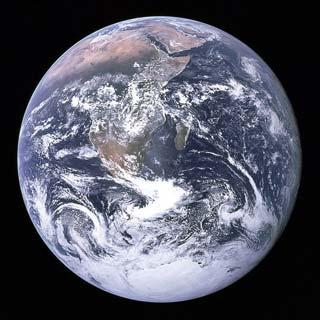Source:
04-22-2009 16:46
Hydrology is the study of the movement, distribution, and quality of water throughout the Earth. The study of the distribution of water is hydrography. The study of the distribution and movement of groundwater is hydrogeology, of glaciers is glaciology, of inland waters is limnology and distribution of oceans is oceanography. Ecological processes with hydrology are in focus of ecohydrology.
 |
| Water covers 71% of the Earth's surface; the oceans contain 97.2% of the Earth's water. The Antarctic ice sheet, which contains 90% of all fresh water on Earth, is visible at the bottom. Condensed atmospheric water can be seen as clouds, contributing to the Earth's albedo. |
The collective mass of water found on, under, and over the surface of a planet is called the hydrosphere. Earth's approximate water volume (the total water supply of the world) is 1 360 000 000 km³ (326 000 000 mi³). Of this volume:
-
1 320 000 000 km³ (316 900 000 mi³ or 97.2%) is in the oceans.
- 25 000 000 km³ (6 000 000 mi³ or 1.8%) is in glaciers, ice caps and ice sheets.
- 13 000 000 km³ (3 000 000 mi³ or 0.9%) is groundwater.
- 250 000 km³ (60 000 mi³ or 0.02%) is fresh water in lakes, inland seas, and rivers.
- 13 000 km³ (3 100 mi³ or 0.001%) is atmospheric water vapor at any given time.
Groundwater and fresh water are useful or potentially useful to humans as water resources.
Liquid water is found in bodies of water, such as an ocean, sea, lake, river, stream, canal, pond, or puddle. The majority of water on Earth is sea water. Water is also present in the atmosphere in solid, liquid, and vapor states. It also exists as groundwater in aquifers.
Water is important in many geological processes. Groundwater is ubiquitous in rocks, and the pressure of this groundwater affects patterns of faulting. Water in the mantle is responsible for the melt that produces volcanoes. On the surface of the Earth, water is important in both chemical and physical weathering processes. Water and, to a lesser but still significant extent, ice, are also responsible for a large amount of sediment transport that occurs on the surface of the earth. Deposition of transported sediment forms many types of sedimentary rocks, which make up the geologic record of Earth history.
Editor:Yang Jie
